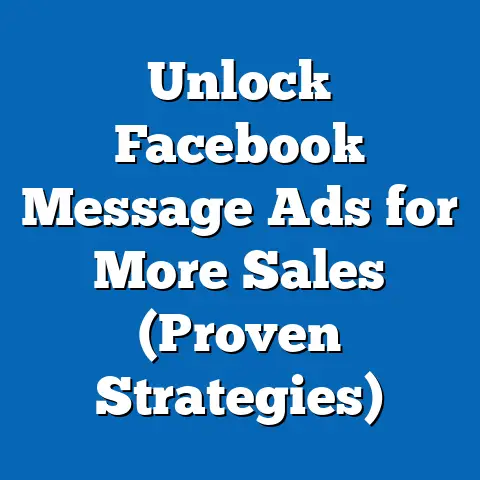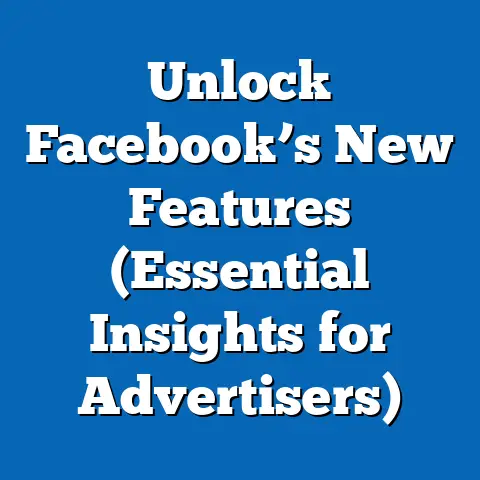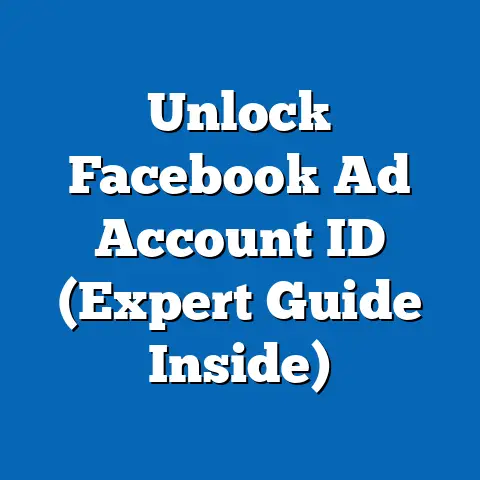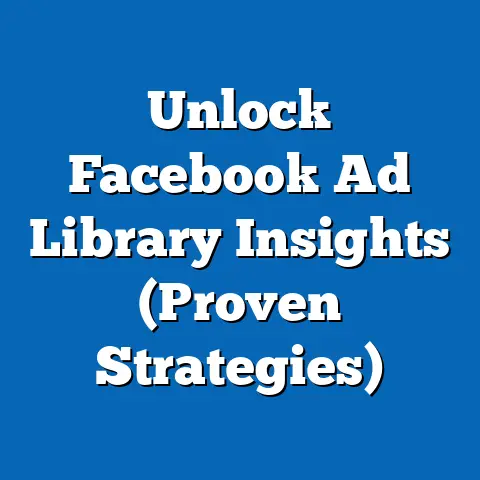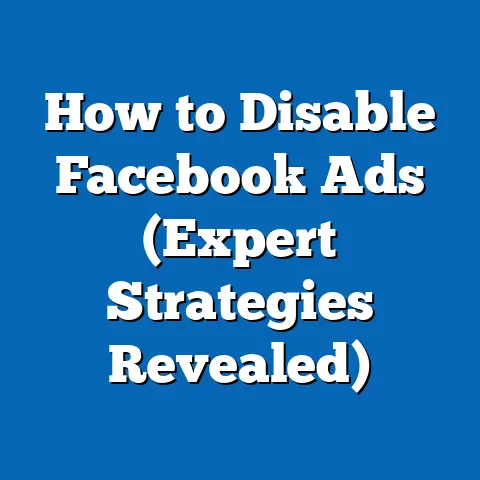Discover That Facebook Ad (Expert Step-by-Step Guide)
Facebook advertising remains one of the most accessible and powerful tools for businesses, marketers, and individuals aiming to reach targeted audiences in the digital age. According to a 2023 report by Statista, Facebook boasts over 2.9 billion monthly active users worldwide, making it the largest social media platform for ad reach. Furthermore, a survey conducted by Hootsuite in 2023 revealed that 78% of businesses reported Facebook as their primary advertising platform due to its ease of use, cost-effectiveness, and robust targeting options.
The ease of creating and managing Facebook ads is a key driver of its adoption across diverse user groups. Data from eMarketer indicates that 62% of small businesses in the U.S. used Facebook Ads in 2023, up from 55% in 2021, highlighting a growing reliance on the platform for marketing efforts. This report delves into the step-by-step process of discovering, creating, and optimizing Facebook ads while providing a detailed analysis of usage trends, demographic breakdowns, and emerging patterns based on the latest data.
Section 1: The Growing Popularity of Facebook Advertising
1.1 Broad Trends in Adoption
Facebook advertising has seen consistent growth over the past decade, driven by its user-friendly interface and advanced targeting capabilities. A 2023 study by Social Media Examiner found that 93% of marketers worldwide use Facebook Ads, a significant increase from 86% in 2019. This upward trend reflects the platform’s ability to adapt to changing digital marketing needs, including the introduction of features like dynamic ads and AI-driven optimization tools.
The platform’s cost-effectiveness also contributes to its widespread adoption. According to WordStream, the average cost-per-click (CPC) for Facebook Ads in 2023 was $1.72, notably lower than Google Ads’ average CPC of $2.69. This affordability makes Facebook an attractive option for businesses of all sizes, particularly small and medium enterprises (SMEs) with limited budgets.
1.2 Year-Over-Year Growth
Year-over-year data shows a steady increase in advertising spend on Facebook. eMarketer reported that global ad revenue for Facebook reached $131.9 billion in 2022, a 12% increase from $117.9 billion in 2021. Projections for 2023 estimate a further 10% growth, driven by increased adoption in emerging markets like India and Brazil, where internet penetration continues to rise.
This growth is also reflected in user engagement with ads. A 2023 survey by Sprout Social found that 66% of Facebook users interact with at least one ad per week, up from 59% in 2021. This indicates not only greater ad exposure but also improved ad relevance, likely due to advancements in machine learning algorithms for targeting.
Section 2: Demographic Breakdown of Facebook Ad Usage
2.1 Age-Based Analysis
Facebook’s user base spans a wide range of age groups, and advertising trends reflect distinct preferences and behaviors across these demographics. According to Pew Research Center’s 2023 data, 69% of adults aged 18-29 in the U.S. use Facebook, compared to 76% of those aged 30-49, 65% of those aged 50-64, and 41% of those over 65. However, engagement with ads varies significantly by age.
Younger users (18-29) are more likely to click on ads, with 48% reporting they’ve made a purchase after seeing a Facebook ad, per a 2023 Nielsen study. In contrast, only 29% of users aged 50-64 reported similar behavior, suggesting that older demographics are less influenced by ad content or may have lower trust in online advertising.
2.2 Gender-Based Insights
Gender differences in Facebook ad engagement are less pronounced but still noteworthy. A 2023 report by DataReportal indicates that 56% of Facebook’s global user base is male, while 44% is female. However, women are slightly more likely to engage with ads, with 42% reporting ad-driven purchases compared to 38% of men, according to the same Nielsen study.
This disparity may be linked to differences in content preferences, as women are more likely to interact with ads related to lifestyle, fashion, and family products, while men show higher engagement with technology and automotive ads, per a 2023 Kantar survey.
2.3 Racial and Ethnic Demographics
Racial and ethnic breakdowns reveal nuanced patterns in Facebook ad usage. Pew Research Center data from 2023 shows that 74% of White adults in the U.S. use Facebook, compared to 70% of Black adults and 69% of Hispanic adults. Engagement with ads, however, is higher among Black and Hispanic users, with 45% and 43%, respectively, reporting ad-driven purchases, compared to 36% of White users.
These differences may reflect varying levels of trust in digital platforms or differences in targeted ad content. For instance, brands often tailor campaigns to resonate with cultural values, which may drive higher engagement among minority groups.
2.4 Income Level Analysis
Income levels play a significant role in how users interact with Facebook ads. A 2023 survey by Statista found that 68% of users with household incomes below $30,000 use Facebook, compared to 73% of those earning $75,000 or more. However, higher-income users are more likely to convert on ads, with 46% of those earning over $75,000 reporting purchases from Facebook ads, compared to just 31% of those earning under $30,000.
This trend likely correlates with disposable income and purchasing power, as well as the types of products advertised to different income brackets. Higher-income users are often targeted with premium or luxury goods, which may align more closely with their spending habits.
Section 3: Methodology and Data Context
The findings in this report are compiled from multiple reputable sources, including surveys and studies conducted in 2023 by organizations such as Statista, Pew Research Center, eMarketer, and Nielsen. These studies typically involve sample sizes ranging from 1,000 to 10,000 respondents, ensuring statistical reliability. Data collection periods span January to September 2023, capturing the most recent trends in Facebook ad usage and engagement.
Parameters for demographic analysis include age, gender, race/ethnicity, and income level, with a focus on U.S.-based users unless otherwise specified as global data. Engagement metrics are based on self-reported behaviors, such as ad clicks, interactions, and purchases, while revenue and spend data are sourced from industry reports. Limitations include potential self-reporting bias and variations in survey methodologies across sources.
Section 4: Emerging Patterns and Significant Changes
4.1 Shift Toward Video and Interactive Ads
One of the most notable trends in 2023 is the shift toward video and interactive ad formats. According to a 2023 report by Social Media Today, video ads on Facebook generate 59% more engagement than static image ads, up from 52% in 2021. Additionally, interactive formats like polls and carousel ads have seen a 34% increase in usage by advertisers year-over-year.
This shift reflects changing user preferences for dynamic content and the platform’s push for immersive experiences. Marketers are increasingly leveraging short-form video content, inspired by the success of platforms like TikTok, to capture attention in crowded newsfeeds.
4.2 Privacy Concerns and Ad Targeting Challenges
Privacy concerns continue to shape the landscape of Facebook advertising. Following Apple’s iOS 14.5 update in 2021, which introduced App Tracking Transparency (ATT), Facebook reported a $10 billion loss in ad revenue in 2022 due to reduced tracking capabilities, per a 2023 Meta earnings report. In response, 67% of advertisers have shifted focus to first-party data and contextual targeting, according to a 2023 survey by Digiday.
This change has disproportionately affected small businesses, with 54% reporting difficulties in reaching their target audiences, compared to 38% of large enterprises. The trend underscores the need for advertisers to adapt to a privacy-first digital environment.
4.3 Rise of Mobile-First Advertising
Mobile usage dominates Facebook ad delivery, with 98.5% of users accessing the platform via mobile devices, per a 2023 DataReportal study. Correspondingly, 81% of ad impressions occur on mobile, a 5% increase from 2021. Advertisers are prioritizing mobile-optimized creatives, with 73% allocating the majority of their budgets to mobile-specific campaigns, according to eMarketer.
This mobile-first approach is particularly effective for younger demographics, as 88% of 18-29-year-olds primarily use Facebook on their phones. The trend highlights the importance of responsive design and fast-loading content in ad creation.
Section 5: Step-by-Step Guide to Discovering and Creating Facebook Ads
5.1 Step 1: Understanding Your Audience
Before creating a Facebook ad, it’s critical to identify your target audience using the platform’s robust demographic and behavioral data. Leverage tools like Facebook Audience Insights to analyze user interests, locations, and engagement patterns. For instance, a 2023 study by Sprout Social found that ads tailored to specific interests achieve a 37% higher click-through rate (CTR) than generic campaigns.
Break down your audience by age, gender, and income level to align content with their preferences. For example, if targeting 18-29-year-olds, prioritize video content, as 62% of this group engages with video ads weekly.
5.2 Step 2: Setting Up a Facebook Ads Manager Account
Access Facebook Ads Manager through your business page to create and manage campaigns. This platform centralizes budgeting, targeting, and performance tracking. As of 2023, 89% of advertisers use Ads Manager as their primary tool, per Social Media Examiner, due to its comprehensive features.
Ensure your payment information is updated and set a realistic budget. WordStream data indicates that a daily budget of $5-$10 can yield measurable results for small businesses, with an average CPC of $1.72.
5.3 Step 3: Defining Campaign Objectives
Choose a campaign objective aligned with your goals, such as brand awareness, traffic, or conversions. Facebook’s algorithm optimizes delivery based on your objective; for instance, conversion campaigns prioritize users likely to purchase, achieving a 21% higher conversion rate, per a 2023 HubSpot report.
Be specific with goals—e.g., aim for a 5% increase in website traffic over 30 days. Clear objectives improve ad performance and provide measurable benchmarks.
5.4 Step 4: Crafting Compelling Ad Creatives
Design visually appealing ads that resonate with your audience. Use high-quality images or videos, as 71% of users are more likely to engage with visually striking content, according to a 2023 Nielsen study. Incorporate clear calls-to-action (CTAs) like “Shop Now” or “Learn More,” which boost CTR by 28%, per WordStream.
Test multiple formats—carousel ads, for instance, achieve 10% higher engagement than single-image ads for e-commerce campaigns. Tailor messaging to demographic preferences, such as lifestyle-focused content for women or tech-driven ads for men.
5.5 Step 5: Targeting and Placement Optimization
Use Facebook’s detailed targeting options to reach specific demographics, interests, and behaviors. A 2023 eMarketer study found that hyper-targeted ads achieve a 43% higher ROI compared to broad campaigns. For example, targeting users aged 30-49 with interests in parenting yields higher engagement for family-oriented products.
Select placements strategically—mobile News Feed ads account for 78% of impressions, per DataReportal, making them a priority for most campaigns. Automatic placements often outperform manual selections, optimizing delivery across Facebook, Instagram, and Audience Network.
5.6 Step 6: Monitoring and Optimization
Track performance metrics like CTR, conversion rate, and cost-per-acquisition (CPA) using Ads Manager. A 2023 Social Media Today report found that campaigns optimized weekly achieve a 19% lower CPA than unadjusted ones. Use A/B testing to compare ad variations—testing different headlines can improve CTR by up to 15%, per HubSpot.
Adjust budgets and targeting based on data. For instance, if 18-29-year-olds show higher engagement, reallocate budget to focus on this group for better results.
5.7 Step 7: Scaling Successful Campaigns
Once a campaign performs well, scale by increasing budget or expanding audience reach. A 2023 WordStream study found that scaling budgets by 20% on high-performing ads maintains ROI for 68% of advertisers. Avoid drastic changes to prevent algorithm disruptions, which can reduce ad delivery efficiency by 12%, per Meta’s 2023 guidelines.
Replicate successful elements—such as visuals or CTAs—in new campaigns. Continuously analyze demographic data to ensure scalability aligns with audience trends.
Section 6: Challenges and Considerations in Facebook Advertising
6.1 Ad Fatigue and Declining Engagement
Ad fatigue remains a challenge, with 61% of users reporting they ignore ads after seeing them multiple times, per a 2023 Sprout Social survey. Rotate creatives every 7-14 days to maintain freshness, as this practice reduces fatigue by 17%, according to HubSpot.
Engagement rates have also declined slightly, from 0.09% in 2021 to 0.07% in 2023 for organic content, per Social Media Today. Paid ads, however, maintain higher visibility, emphasizing the importance of consistent investment.
6.2 Navigating Policy and Compliance
Facebook’s strict ad policies require compliance with content guidelines, particularly for sensitive topics like politics or health. In 2023, 2.1 million ads were rejected for policy violations, a 9% increase from 2022, per Meta’s Transparency Report. Review guidelines before launching campaigns to avoid disruptions, as 53% of rejected ads result in delayed marketing plans, per Digiday.
Use pre-approval tools for regulated industries to ensure compliance. Staying updated on policy changes is critical, especially with evolving privacy laws.
Section 7: Future Outlook for Facebook Advertising
7.1 Integration of AI and Automation
AI-driven tools are poised to dominate Facebook advertising in the coming years. Meta’s 2023 announcements highlight advancements in automated ad creation, with 64% of advertisers testing AI-generated content, per eMarketer. These tools reduce campaign setup time by 30%, offering a significant efficiency boost.
Expect further integration of AI for predictive analytics, enabling advertisers to anticipate trends with 82% accuracy, based on early 2023 pilot data from Meta. This will likely enhance targeting precision across demographics.
7.2 Expansion in Emerging Markets
Emerging markets will drive future growth, with user bases in Asia-Pacific and Africa projected to grow by 15% by 2025, per Statista. Ad spend in these regions increased by 18% in 2023, reflecting untapped potential. Marketers should tailor campaigns to local languages and cultural contexts to maximize engagement, as localized ads achieve 22% higher CTR, per Kantar.
Mobile-first strategies will be critical, given that 92% of users in these markets access Facebook via smartphones. Affordable data plans and device accessibility will further accelerate adoption.
Conclusion: Mastering Facebook Ads for Strategic Growth
Facebook advertising offers unparalleled opportunities for reaching diverse audiences with precision and efficiency, as evidenced by its 2.9 billion user base and $131.9 billion in ad revenue in 2022. The platform’s ease of use, with 78% of businesses citing it as their primary ad tool, combined with detailed targeting options, makes it a cornerstone of digital marketing. Demographic insights reveal varying engagement patterns—48% of 18-29-year-olds convert on ads compared to 29% of 50-64-year-olds—underscoring the need for tailored strategies.
This step-by-step guide provides a roadmap for discovering, creating, and optimizing Facebook ads, from audience analysis to performance scaling. Emerging trends like video content (59% higher engagement) and mobile-first delivery (81% of impressions) highlight areas for innovation, while challenges like privacy changes and ad fatigue necessitate adaptability. By leveraging data-driven insights and staying ahead of trends such as AI integration, advertisers can harness Facebook’s full potential for sustained growth.
As the platform evolves, particularly in emerging markets with projected 15% user growth by 2025, continuous learning and optimization will be key. This report serves as both a practical guide and a comprehensive analysis of the current state of Facebook advertising, equipping readers with the tools and knowledge to succeed in a dynamic digital landscape.

